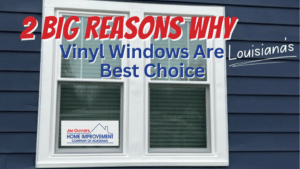Unravel the ‘Vinyl vs Wood Siding’ debate: Learn the key differences and find out why Jim Olivier’s Home Improvement has a clear favorite.
Introduction to the ‘Vinyl vs Wood Siding’ Debate
Looking to renovate your home? Whether you just moved in, looking for a major face-lift, or repairing storm damage, choosing exterior materials for our homes isn’t something people do normally (unless you’re a contractor like us). We get it.
But… if you are in this position, we want to make sure you are well-informed so you can make the best decision for your home.
The purpose of this article is to compare and contrast vinyl siding and wood siding by highlighting the top 5 differences between the two. Whether you are more about being eco-friendly or cost-effective, it is crucial to understand the pros and cons of each home improvement option. So, let’s take a closer look at the durability, maintenance, cost, appearance, and environmental impact of vinyl vs wood siding. Ready?
Durability:
In Louisiana, durability is a key factor to consider when choosing between vinyl vs wood siding. We love living here, but Louisiana’s weather is harsh on our homes. It’s smart to choose materials that best stand up to the elements.
Vinyl siding is known for its long-lasting and weather-resistant properties, making it a popular choice among homeowners—particularly in the South. Unlike wood siding, which can rot, warp, or become infested with insects, vinyl siding is not as affected by moisture, temperature changes, or insects. This means that it requires very little maintenance and can last for many years without needing to be replaced.
Wood siding can last for a long time as well, but it requires regular maintenance to protect it from the elements. It is also susceptible to warping, splitting, or cracking due to exposure to moisture, heat, and other weather conditions.
For Durability: Jim Olivier’s chooses Vinyl
- Resistant to moisture, temperature changes, and insects
- Requires minimal maintenance
- Can last for many years without needing to be replaced
- Offers long-lasting and weather-resistant properties
Maintenance:
In the ‘Vinyl vs Wood Siding’ comparison, maintaining the appearance of your home’s exterior presents different challenges and benefits. Wood siding necessitates regular painting or staining to preserve its look and shield it from the elements, which can be a time-consuming and expensive task, particularly if a color change is desired. Conversely, vinyl siding is straightforward to clean and maintain, requiring minimal upkeep and repairs, making it a more convenient choice.
The only “con” for vinyl siding is that it shouldn’t be painted over. The color you choose at first is the color it will be until it’s replaced again.
For Maintenance: Jim Olivier’s chooses Vinyl
- Easy to clean and maintain. Dirt, grime, and mildew can be easily cleaned off vinyl siding with soap and water.
- Resistant to chipping, cracking, and fading, so it will look good for years to come with minimal effort.
- Requires minimal upkeep and repairs. Unlike wood siding, vinyl siding does not rot, split, or warp, so it does not need to be replaced as often. This means you can save money on repairs and replacements over time.
Cost:
When considering siding options for your home, the cost is commonly an important factor to take into account. Wood siding may be more affordable upfront, especially if you only want to repair and repaint. However, its regular maintenance costs (such as painting or staining and repairs) add up over time.
Depending on the price of wood, vinyl siding may be more affordable upfront. More importantly, it requires less maintenance, which results in lower long-term costs compared to wood siding.
For Cost: Jim Olivier’s chooses Vinyl
- More affordable overall cost: Vinyl siding has a lower long-term cost due to less maintenance. Save money on repairs and repainting.
- Longer lasting: You won’t have to replace vinyl siding as quickly as wood, making vinyl a more cost-effective option in the long run.
Appearance
When it comes to the appearance of your home’s exterior, both vinyl and wood siding have their pros and cons. Wood siding can offer a natural and traditional look, but it can also quickly look worn and faded over time if not properly maintained. On the other hand, vinyl siding can offer a wide range of colors and styles and it maintains its high-quality look for years to come (with minimal effort).
For Appearance: Jim Olivier’s chooses Vinyl
- Wide range of colors and styles to choose from: Homeowners cab choose a siding that matches the style of their home and their personal preferences.
- High-quality look and feel: Vinyl siding has a high-quality look and feel that resembles wood siding, but it requires less maintenance and lasts longer, making it a more visually appealing option. Additionally, vinyl siding is resistant to chipping, cracking, and fading, so it will look good for years to come.
VI. Environmental Impact
In recent years, homeowners have become increasingly conscious of the environmental impact of their choices. When it comes to siding options, both vinyl and wood have their own set of environmental concerns. Wood siding is a natural material that is biodegradable (pro), but it requires the harvesting of trees, which can have a negative impact on the environment (con).
On the other hand, vinyl siding is made from synthetic materials and can have negative environmental impacts due to the production process and it’s not biodegradable (con). However, vinyl siding is often made from recycled materials, reducing the amount of waste in landfills and conserving natural resources (pro).
In addition, Vinyl Siding has a 4.0 R-value and is energy star rated. This not only means lower energy bills, but, more importantly, less energy consumption. Less consumption means less production (pro).
For Environmental Impact: Jim Olivier’s chooses Vinyl
- Recycled materials, reduction of waste in landfills, and less consumption of natural resources.
- Energy-efficient and eco-friendly: Vinyl siding is energy-efficient, with a 4.0 R-value. This reduces the amount of energy needed to heat and cool your home. Additionally, many vinyl siding manufacturers are taking steps to reduce the environmental impact of their products, making vinyl siding a more eco-friendly option.
Conclusion: Vinyl Siding
In conclusion, when examining the ‘Vinyl vs Wood Siding’ debate, there are several key differences that homeowners should consider when selecting a siding material for their home. Vinyl siding emerges as a clear winner with numerous benefits, including its durability, low maintenance requirements, affordable cost, wide range of colors and styles, and eco-friendly attributes. When stacked against wood siding, vinyl siding proves to be the superior choice, making it the optimal selection for Acadiana’s siding needs.
At Jim Olivier’s Home Improvement, we offer a wide range of vinyl siding options that are durable, low maintenance, and affordable. Our team of experts will work with you to choose the best siding solution for your home and provide a Red Carpet Experience so that the installation process is as stress-free as possible.
In summary, if you are looking for a siding solution that is both affordable and high-quality, vinyl siding may be the right choice for you. We recommend considering all your options and weighing the benefits of each before making a final decision. And if you need assistance, our team at Jim Olivier’s Home Improvement is here to help.




